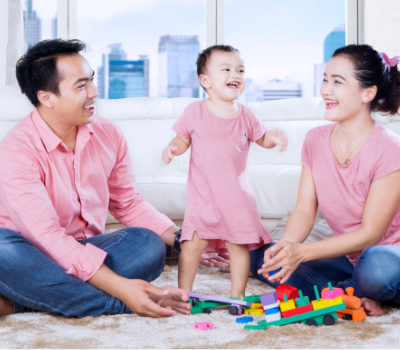Introduction
 Preschool play is complex and between the ages of 3 and 6 years, imaginative fantasies, narrative language and mentalization all begin to emerge (Davies, 2011; Luby, 2006; Meersand & Gilmore, 2018). It is during this developmental period that play becomes one of the “primary mediums for communication, relationship building and therapeutic action” (Meersand & Gilmore, 2018, p. 11). Given the clinical utility of play across multiple early childhood mental health interventions, it’s important to bring awareness to our relationship with play. Reflecting on our own early childhood play experiences can deepen our understanding of the play experience and the role of others in play. These reflections can help us gain insight into our work including how we create play spaces to facilitate relationships between young children and parents/caregivers.
Preschool play is complex and between the ages of 3 and 6 years, imaginative fantasies, narrative language and mentalization all begin to emerge (Davies, 2011; Luby, 2006; Meersand & Gilmore, 2018). It is during this developmental period that play becomes one of the “primary mediums for communication, relationship building and therapeutic action” (Meersand & Gilmore, 2018, p. 11). Given the clinical utility of play across multiple early childhood mental health interventions, it’s important to bring awareness to our relationship with play. Reflecting on our own early childhood play experiences can deepen our understanding of the play experience and the role of others in play. These reflections can help us gain insight into our work including how we create play spaces to facilitate relationships between young children and parents/caregivers.
Exploring Our Play Experiences
Play is something we begin to experience in infancy and throughout our lifetime. When we play, we experience ourselves and others in different ways that can naturally lead to moments of trust, empathy, regulation, tolerance and/or resolutions. One of my favorite quotes about play is “Play matters because people matter. It reminds us of our interdependence and gives us a chance to really see other people and, in turn, to be really and truly seen” (Vialet, n.d.). One way to bring awareness to our relationship with play is to think about the context of our play experiences. As a young child, where do we remember playing the most (e.g. home, school, neighborhood)? How often did you play? Who did you play with (e.g. siblings, parents, peers, others)? When you think about these memories, take a minute to notice what you are feeling and where in body you are feeling this. Keeping a journal to write (or draw) your reflections and sharing them with your reflective supervisor can be very helpful in this process. In thinking about the play itself, did you have a favorite toy, game or other play memory? Does your favorite memory include non-directive, directive or a combination of both types of play? You may also want to explore the process of play and how you participated in the play. Did you take the lead in the play? Were you comfortable taking the lead? How did others participate in your play? When others participated, did you feel seen and/heard? When exploring these particular aspects, do you notice similar or different feelings than you had before. If so, add these to your journal and/or artwork and again and/or share with your supervisor.
As you explore your play experiences, you may notice a cultural context to them. In early childhood and throughout adolescence, our play can influence the development of our racial, ethnic, gender or religious identities (Davies, 2011; Meersand & Gilmore, 2018). Our cultural identities can also influence our play, and this includes the exploration of adult roles and social norms in sociodramatic play (Meersand & Gilmore, 2018). Additionally, our cultural identities can shape our play preferences, the time and space allotted for play and/or the availability of play partners (Gosso et al., 2013). Individual and parent perception about the function of play (Izumi-Taylor et al., 2010) and parent and community investments (Roopnarine & Davidson, 2015) are also cultural aspects to consider.
Examining the cultural context of our play helps us to gain insight into the role that our identities have in shaping early childhood play experiences.
Given our identities change over time, it may be helpful to think about how our play stayed the same or changed later in childhood and adolescence.
Supportive Play Spaces in the Assessment Phase
An increased awareness of our relationship to play and its cultural context can also generate understanding into how we create and facilitate supportive play spaces. The assessment phase is often when we begin to bring toys and/or play into the clinical space. It is important to talk with parents and provide psychoeducation about why we use play as a primary tool with young children ages 3 to 6 years. It can also be helpful to explore the parent’s experience with play as part of the assessment. We can ask the child, “What is your favorite toy or game? We can ask parents if they “had a favorite toy, game or play memory from their childhood?” Taking notice of what type of play the parent describes and if/how others were involved in the play can lead to other questions like, “Do you play the same game with your child or is there a different game that you like to play?” These responses can help to assess the types of play the parent has experience with as a child and with their own children. We can also begin to learn about the possible role of play within the parent-child or other relationship.
The use of non-directive/child-centered play in the assessment process is considered an evidenced-based practice (Mortenson & Mastergeorge, 2015). These observations help clinicians to assess toy or play preferences, play skills (e.g. ability to lead or follow the play) and if/how the play facilitates parent-child interactions. This can be set up by asking the parent and child to play together for a brief amount of time (maximum of 15 minutes). A range of toys that facilitate interaction and imagination can be selected by the clinician and the play space can be established with a blanket or an area within the home. During this time, the clinician’s aim is to observe unless asked to participate by the child or parent. Directive or structured play can also help to assess tolerance and other play skills such as permissiveness. The toys and materials for these play activities may be different and require the clinician to structure the task and/or provide support throughout. Processing the play with parents afterwards is very important to building the clinician-parent relationship. However, equally important is the need for you to reflect on your observations or experience being involved in the play. Knowing your relationship to play will help in this process as you begin to identify what relationship and/or play supports may be needed.
Supportive Play Spaces in the Intervention Phase
As we move into the intervention phase, we need to continue to be intentional about supporting and creating safe play spaces. After checking-in with parents each week, it can be beneficial to prep parents before the play session on the overall aim or focus of the play and their specific role (Farley & Whipple, 2017). This allows parents/caregivers a space to ask play specific questions, practice play skills (if needed) and gain support for their role in the play process. Research indicates that when check-ins include prepping parents for the play, it can increase parental engagement in sessions (Farley & Whipple, 2017).
parents each week, it can be beneficial to prep parents before the play session on the overall aim or focus of the play and their specific role (Farley & Whipple, 2017). This allows parents/caregivers a space to ask play specific questions, practice play skills (if needed) and gain support for their role in the play process. Research indicates that when check-ins include prepping parents for the play, it can increase parental engagement in sessions (Farley & Whipple, 2017).
Once the play session begins, we need to be aware of our presence within this process.
As previously highlighted by DeSchryver (2020), therapeutic presence can be defined as “…as having one’s whole self in the encounter with a client by being completely in the moment on a multiplicity of levels–physically, emotionally, cognitively, spiritually and relationally” (Geller & Greenberg, 2012, p. 7). It can be difficult to be present while immersed in the playing state of a young child and equally focused on the centrality of relationships.
We often reflect on the child and parent’s presence in the play, but it can also be helpful to think about our presence and its potential impact on the play.
One way that we can monitor our presence is to reflect on some of the following elements outlined in a tool created by Yasenik & Gardner (2011) to monitor clinical use of self:
- Verbal Discussions: The amount that you were involved in verbal exchanges and who led the discussion and if these discussions were in or outside of the play activity.
- Reflective Statements: The amount that you tracked the play and/or providing reflective content on thoughts/feelings, decision-making, esteem or relationships.
- Emotionality: The amount that your responses reflected or mirrored the emotions of the child or parent (this includes voice tone, facial or body gestures or comments made to elaborate expressions).
- Physical Self: The amount you engaged physically into the play, type of contact and level of energy.
- Interpretations: The amount you included soft hypotheses and used the play to test these hypotheses or the amount you pointed out a pattern or directly made interpretations to raise a matter to conscience awareness.
Reflecting on these pieces can help to raise awareness of our play presence and its impact on the play and/or how it facilitates relationships. Exploring these aspects with parents after the play may also help to increase their awareness into own presence and how they contribute and support the play process.
Summary
Exploring our own play experiences can help us gain a greater awareness of our relationship to play. This awareness can deepen our understanding of our perceptions including the role of others in play. Through this process, we can learn how play influences the development of our cultural identities and/or how our cultural identities shape our play. These insights can ground our work and help us to create supportive play spaces that facilitate relationships. During the assessment process, we need to be intentional about gathering information about the child and parent/caregiver’s play experiences and facilitating play observations. Observations can identify play strengths and areas of need, which allows us to identify specific ways we can help support parents/caregivers. Within the intervention process, we need to work to actively engage parents/caregivers in the play process by providing psychoeducation and preparing parents/caregivers for each play session. Finally, we need to continually reflect on both our play and relational presence in order to begin “unpacking” the complexities of the parent-child relationships and meanings of play with preschool children and their parents/caregivers.
References
- Davies, D. (2011). Child Development: A Practitioner’s Guide. The Guilford Press.
- DeSchryver (2020, November 10). The Critical Component in Providing Relationship-Based Services via Telehealth. The Infant Crier. Retrieved from https://infantcrier.mi-aimh.org/therapeutic-presence-the-critical-component-in-providing-relationship-based-services-via-telehealth/
- Farley, J. & Whipple, E. E. (2017). Expanding Infant Mental Health Treatment Services to At-Risk Preschoolers and their Families Thought the Integration of Relational Play Therapy. Infant Mental Health Journal, 38(5), 669-679.
- Geller, S. M. & Greenberg, L. S. (2012). Therapeutic Presence. American Psychological Association (APA) Publishing.
- Gosso, Y. & Carvalho, A. (2013). Play and Cultural Context. Retrieved from: https://www.researchgate.net/publication/304626147_Play_and_Cultural_Context
- Izumi-Taylor, S., Samuelsson, I. P., & Rogers, C. S. (2010). Perspectives of play in three nations. Early Childhood Research and Practice, 12(1), 1–12.
- Meersand, P. & Karen J. Gilmore (2018). Play Therapy: A psychodynamic primer for the treatment of young children. American Psychological Association (APA) Publishing.
- Luby, J. L. (2006). Handbook of Preschool Mental Health. The Gilford Press.
- Roopnarine, J. L. & Davidson, K. L. (2015). Parent-Child Play Across Cultures: Advancing play research. American Journal of Play, 7(2), 228-251.
- Yasenik, L. & Garner, K. (2011). Play Therapy Dimensions Model: A decision guide for integrative therapists. Jessica Kingsley Publishers.



